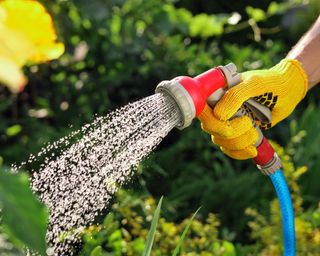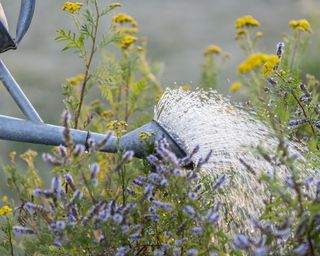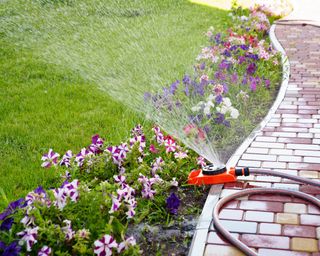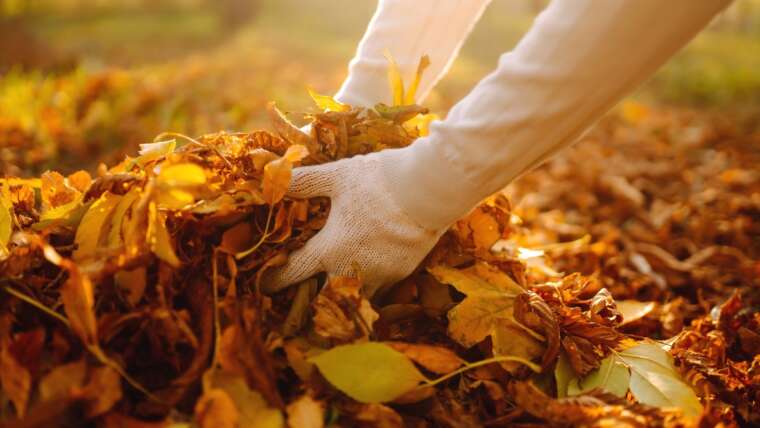We all know plants need water, but working out how much, how often, and when to water them causes confusion. Even the most seasoned gardener can make errors when watering the garden.
Multiple factors have an impact that makes it difficult to provide specific answers. Drying winds, a full sun or partial sun location, in-ground or container plants, the type of soil, and the variety of plants will all dictate the best watering method.
However, there are a few basic rules to follow that will ensure plants are getting the moisture they need to thrive.
Where possible, try to collect and use rainwater to irrigate the garden. This saves precious natural resources but is also better for plants as rainwater is chemical-free and has the ideal pH.
(Image credit: Alamy)
1. Too Much – Or Too Little – Water
It might seem like a good idea to keep a diligent pace on watering, ensuring the soil is wet at all times. However, many plants are damaged by excess moisture in the soil, especially when it is soggy.
Plants uptake water primarily through their roots, although some enters through the leaves. This uptake is fairly slow and the plant only takes what it needs. So if the soil is soggy, the roots are just sitting in moisture.
The wet soil activates a variety of pathogens which can then attack the roots. As a result, root rot and other issues may ensue.
Look out for signs of overwatering such as yellow leaves, wilting, and algae growth.
Similarly, underwatering can damage plants. When a plant lacks water it cannot produce new cells and sustain the existing plant material. The cells will shrivel leading to limp, wrinkled plant material.
If the condition persists, the plant will die. Even succulent plants need moisture with a brief period of dryness to thrive.
2. Watering At The Wrong Time
Timing is everything, and this holds true with watering practices. If you water at the height of the day when the sun’s rays are strongest, evaporation will take away some of that water. This is a waste of water and the moisture doesn’t have time to penetrate soil.
Watering during high heat can also damage plants. Any water that gets on the plant acts like a mini magnifying glass, enhancing solar heat and burning the plant.
The best time to water is in the morning when it is cooler and plants can absorb moisture. This also prevents leaves from remaining wet, which can promote fungal issues.

(Image credit: Shutterstock)
3. Splashing The Plant
Many bacteria and soil-borne diseases lurk in the soil. When we irrigate too rapidly, the muddy water splashes on the leaves. Damping off, vascular wilt, and root rot are a few of the potential consequences.
If possible, avoid overhead watering, and instead deliver moisture directly to the base of the plant. Soaker hoses or drip systems are effective ways of preventing fungal and other diseases on the plant material.
4. Not Watering Deeply
Deeply and infrequently is a good model for most plants. When we water deeply, the moisture gets to the roots.
Watering too shallow will just allow for evaporation while failing to get moisture to the roots for uptake. It also produces a shallow and weak root system that is close to the surface of the soil. This is destabilizing for the plant and the roots may be harmed when we cultivate around the plant.
When you water deeply, the roots grow better and more deeply.

(Image credit: Getty Images)
5. Treating All Plants The Same
Every plant has individual care needs. While you could lump together all succulents or all forest plants with similar care, the garden is often diverse. You may have hens and chicks nestled against an ornamental plant that needs more water.
Giving all the plants in a certain bed the same water may not be good for some of those species. The most sensible practice is to only install plants with the same watering needs in a site, but sometimes this doesn’t happen.
Know your plants and treat them like individuals when it comes to watering.
6. Watering On A Schedule
We live busy lives and it’s easy to forget daily details. So for this reason we often do a watering schedule using an automated irrigation system. This is fine for the lawn, but in mixed garden beds, it can do more harm than good.
Instead of giving the plants water at a predetermined time, just manually check them to see if they need water. Slope, drainage, sun exposure, wind, and other factors will change the soil moisture.
If necessary use a soil moisture meter to determine if adequate moisture remains in the soil.

(Image credit: Shutterstock)
7. Not Using Mulch
If you have bare soil around your plants, the moisture will evaporate rapidly in the sun. Mulching will keep the moisture in while also helping to cool the soil in summer, and keep it warmer in the winter.
There are both organic and inorganic mulches. Organic mulches include leaf litter, bark pieces, and straw. Inorganic mulches may be recycled tire bits, rocks, or gravel. Both work to protect soil and conserve moisture, while also preventing some weeds.



